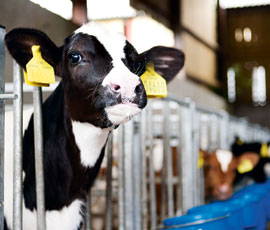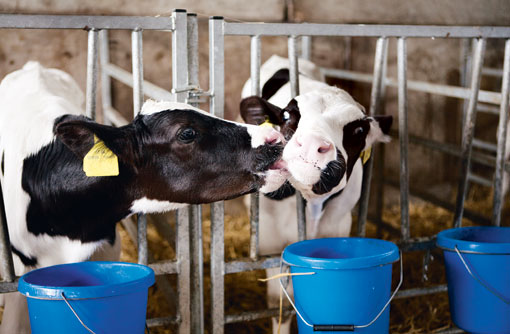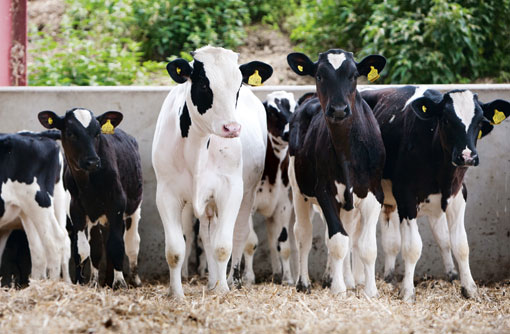Technical aspects of rearing veal calves

Veal is something that is gaining interest among farmers as they look for alternative uses for dairy-bred bull calves.
About 3,000t of veal is consumed annually in the UK – but around half is still imported. As it becomes less acceptable to remove black and white dairy-bred bull calves from the food chain at birth, veal production is attracting wider attention.
And although veal remains an issue with some consumers, the market is expanding.
But what is veal?
The widely held perception of a veal calf is one fed solely on milk. But there is a wide range of systems in the UK producing “rose” veal – a term referring to the delicate colour of the meat.
Some veal calves reared to six to eight months old are fed milk as part of the diet from birth to slaughter. Others receive no milk after eight weeks, while some systems are taking calves to almost 12 months old and marketing them as veal – a contentious issue among “purist” veal producers.
Emily Phelps and Adam Don, Gloucestershire

High standards of animal welfare are fundamental to the way Adam Don and Emily Phelps rear veal calves at their farm near Tewkesbury, Gloucestershire. But nutrition – and in particular meeting the calves’ energy requirement – is a critical part of the system.
Using British Blue-sired bull and heifer calves from the 140-cow Holstein herd run by Ms Phelps’ parents, the couple’s “rose” veal business is thriving. But while they say the high rearing standards they adhere to are in line with those applied to conventional calf rearing, close attention to detail is even more essential to ensure good health and sustained growth rates.
The calves, taken to 200kg liveweight by six months old, are produced on a system that exploits the high energy needs of the growing calves by feeding a top-quality forage mix from weaning at eight weeks.
At birth, all calves receive a minimum of 3 litres of colostrum in two feeds from a bank of frozen colostrum.
“This is paramount,” says Mr Don. “It ensures we get calves off to the best possible start and because we don’t undertake any routine medication, the colostrum provides the essential antibodies. The correct diet, careful management, a natural rearing environment and no stress minimises health issues, and while we do use a gel or an electrolyte to cope with scours, we rarely have to.”
Calves are housed in outdoor hutches in groups of four or five, with ample straw for bedding. Whole milk is fed in two daily feeds of 2.5 litres a head through a teat feeder. Calves have access to a small amount of a molasses coarse mix that’s kept fresh and topped up at each feeding time. The coarse mix comprises 15% soya, 20% hulls, 20% rape meal, 40% rolled wheat, 1% salt, 2% minerals and 2% molasses.
“Although it’s ad-lib, we find the yokes in the hutch system encourage them to nibble on the feed after a milk feed, and leaving them in the yokes for a while after feeding lowers the incidence of cross-suckling,” says Mr Don.
But at four weeks the calves are introduced to what is the most significant stage of the rearing system – a “very good quality TMR that could be fed to high-yielding dairy cows” – 25% maize silage, 50% grass silage, 25% chopped straw and a concentrate mix.
“It’s important to keep the TMR as fresh as possible in the same way that we like the coarse mix to be, and we top it up at the evening feed with extra maize. We also sprinkle some coarse mix on top of the TMR.”
Calves are gradually weaned on to this diet at eight weeks old by reducing the milk ration in stages until two feeds of 1 litre each are reached. They are then moved to loose straw yards and fed the same TMR ration until slaughter.
“We were adding coarse mix, but we’ve improved things by putting fresh maize silage on top of the TMR in the evening to provide the energy levels these calves need. It’s convenient, the most economical way of boosting the diet’s energy and great for calf health,” adds Mr Don.
But Mr Don and Ms Phelps believe managing calves at this stage demands a degree of flexibility. “The best results are achieved by not being too prescriptive and allowing yourself to react to the calves’ performance. Rearing veal calves requires attention to detail, flexibility and sensitivity,” he says.
Growth rates are around 1.1kg/day but that takes account of the “check” at weaning.
“The slight slowing down in growth when we switch off the milk and move on to the TMR is acceptable. The calves soon make it up and in the long term, feeding the forage mix is by far the most efficient and economical way of maintaining energy intakes.
“Because we are selling calves at six months weighing 200kg liveweight, the meat remains tender and has a better flavour by being fed the forage-based diet instead of all cereals,” says Mr Don.
Jon and Vicky Brown, Cornwall

Jon and Vicky Brown of Bocaddon Farm Veal, Looe, Cornwall, have been producing veal for about six years and believe that milk should remain part of the diet from birth to slaughter. “It’s the most natural way for the calf to live and also ensures the meat has flavour and tenderness,” says Mr Brown.
After several years of rearing calves themselves, all calves are now reared on contract.
“When we started there was no one to advise us how to rear calves for veal and produce the high-quality product we required. We learned from experience, and while there are some basic management similarities with rearing calves that will go on to be dairy or beef animals, because we were producing veal calves the system had to rely on milk being fed throughout the calf’s life,” he explains.
Mr Brown says the business had two aims: to give the calves a good life and rear them to the highest standard and provide a natural milk-based diet.
“We were initially told not to feed hay and to avoid iron in the diet – but we haven’t followed that advice. What we produce isn’t just about the colour of the meat.” he says.
“We medicate as little as possible, even though we had conflicting advice in the early days.”
Calves are reared on straw in small groups in open-fronted accommodation. Whole milk is fed for the first week, then replaced by powdered milk. Calves are fed twice a day and have ad-lib access to a standard calf-rearing pellet.
“In our experience we’ve found a good-quality calf-rearing pellet is adequate and provides enough energy and protein to a diet that continues to be supplemented with milk throughout the calf’s life.
“But we believe avoiding weaning the calves is the key to the system.”
Mr Brown accepts continuous milk feeding is a “big expense”, but says it ensures the quality of the veal and avoids the “weaning check”.
Milk intakes are controlled up to a limit of 6 litres/day until calves reach a slaughter weight of around 250kg at six to eight months old.
Veal rearing facts
- Decide on a system – all milk to slaughter or traditional weaning
- Natural rearing – hutches are ideal
- High-quality forage can meet energy needs
- Small groups ensure high welfare standards
- Close attention to detail needed
- Treat calves with sensitivity and be flexible
- Minimal vet and med required if management is good
